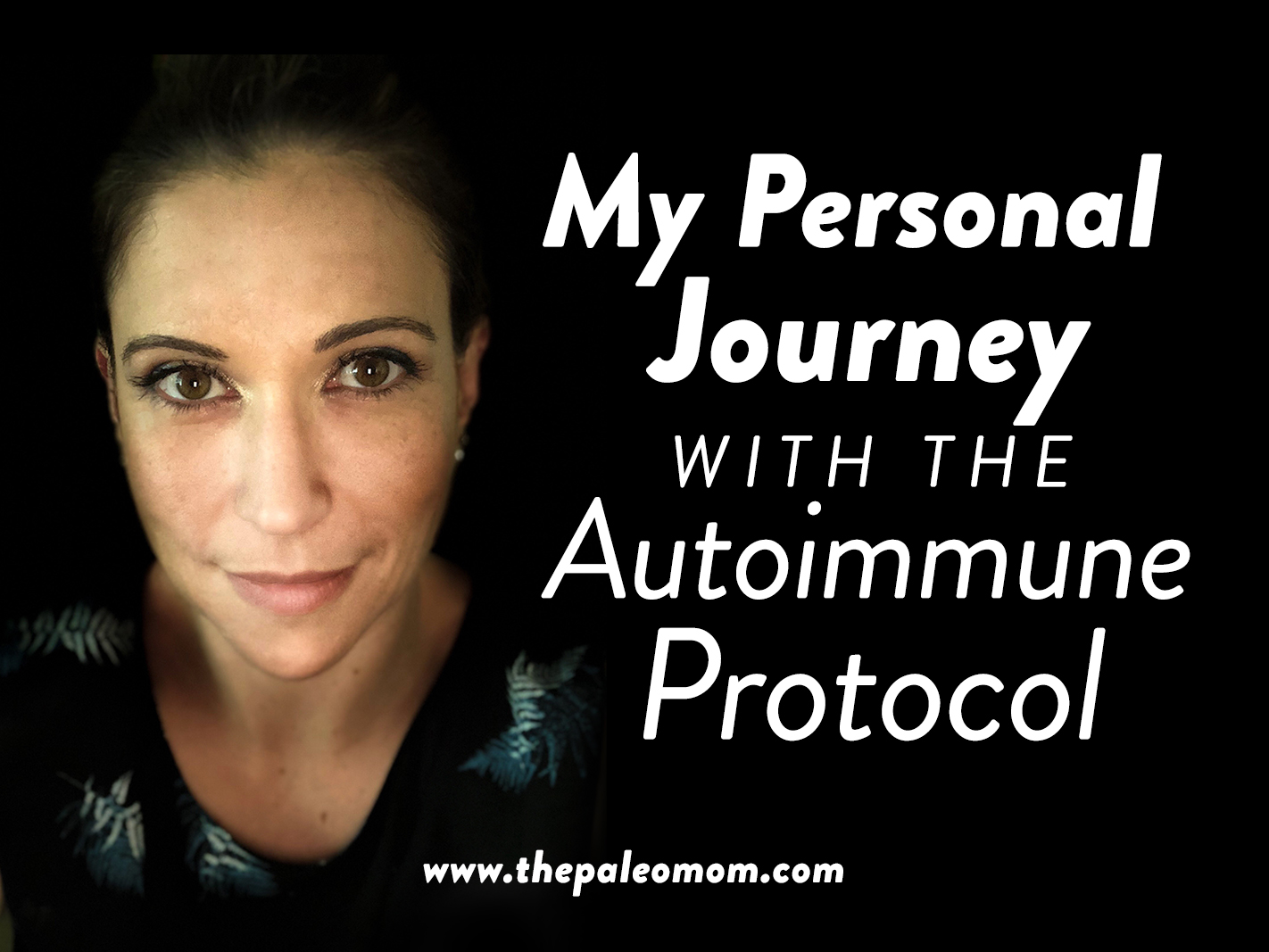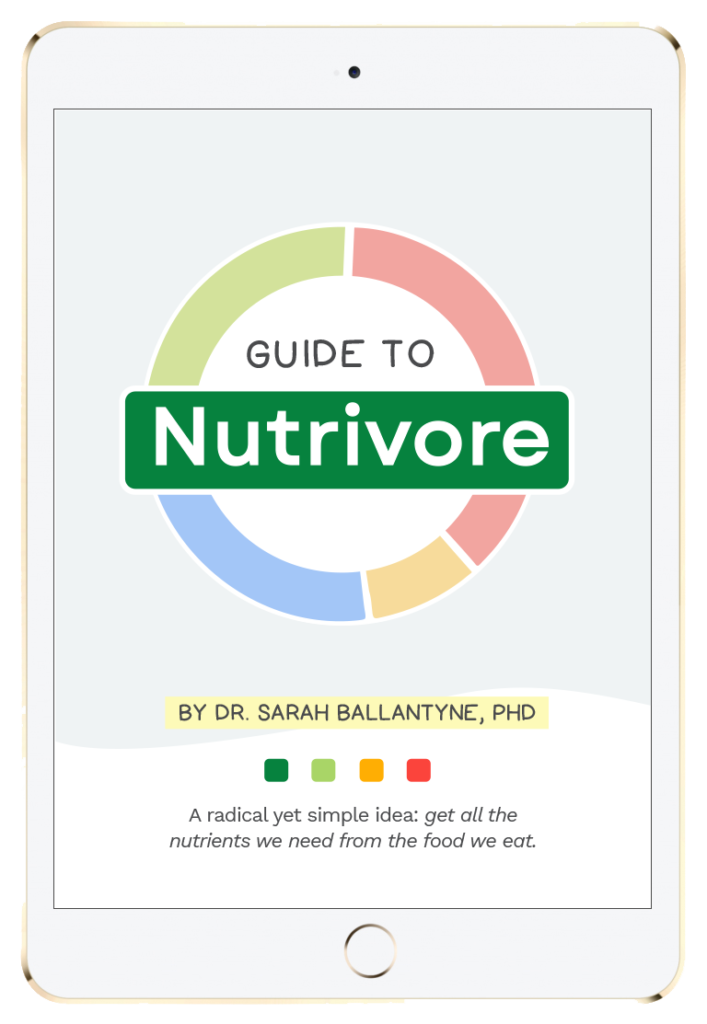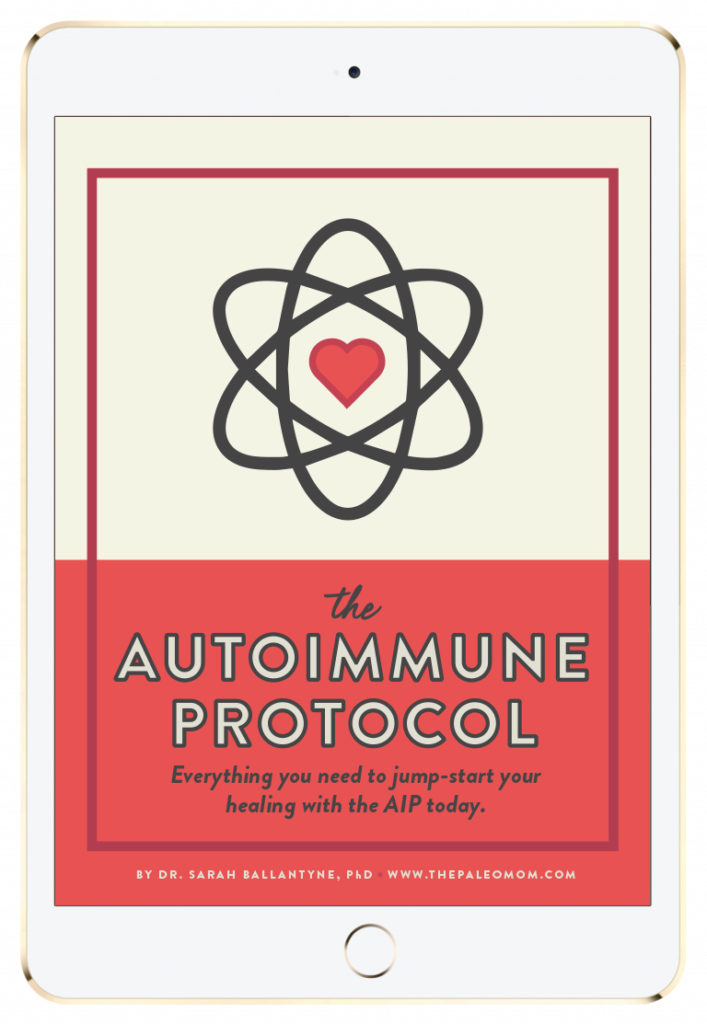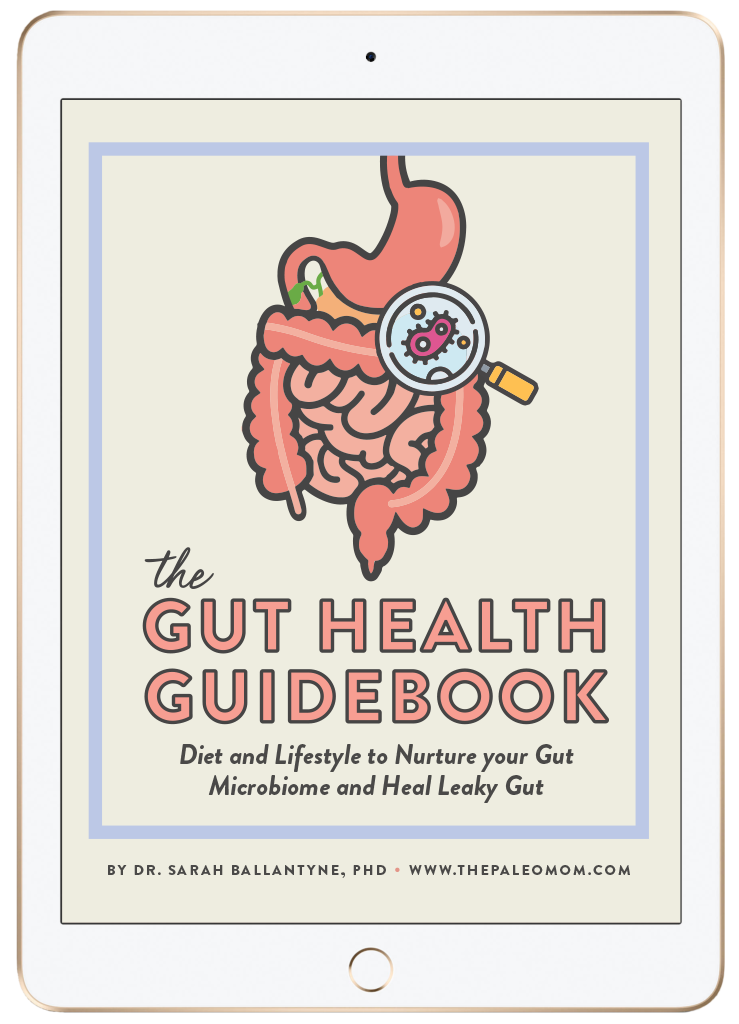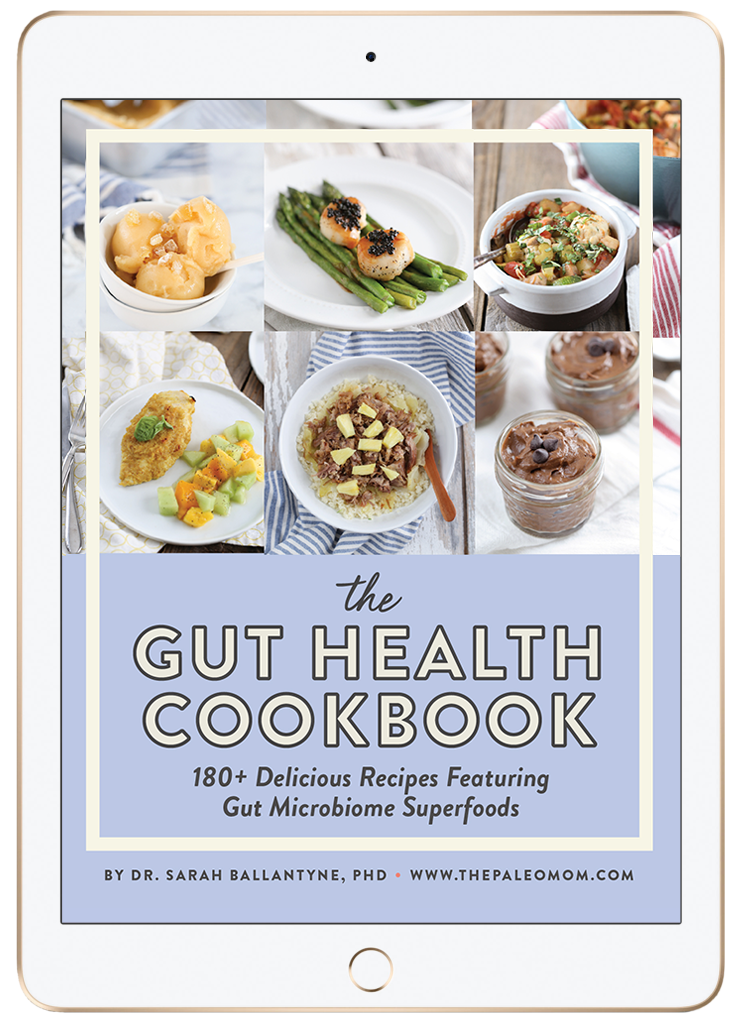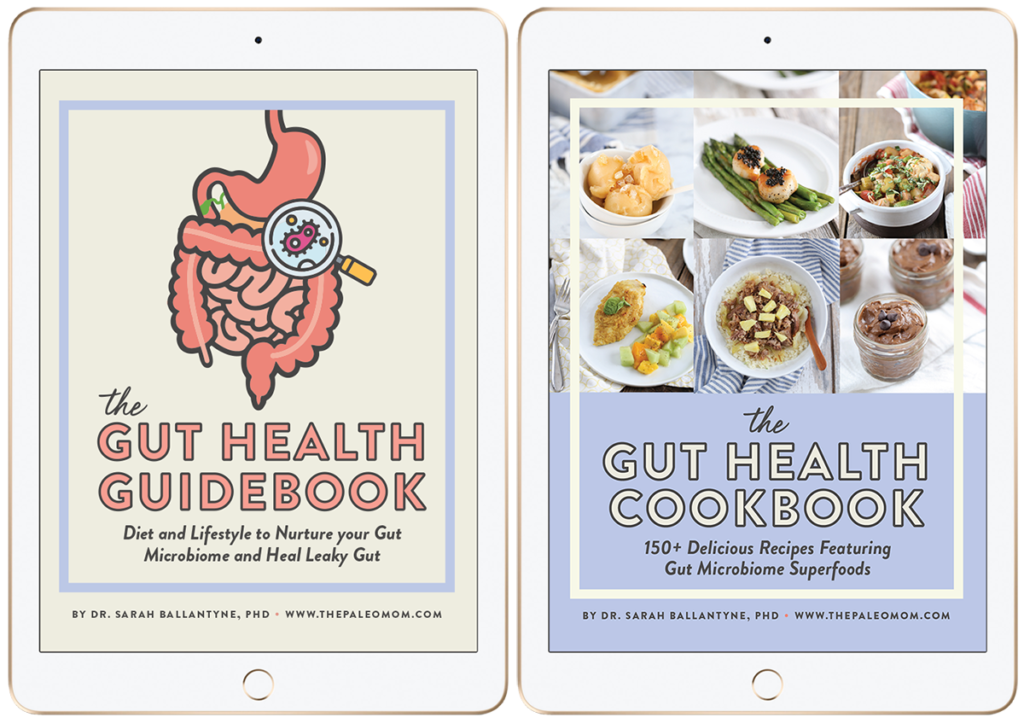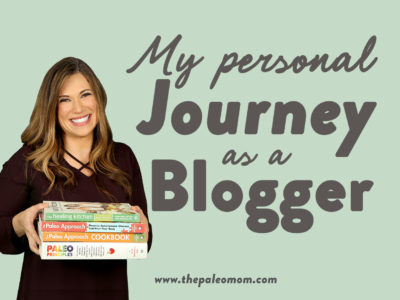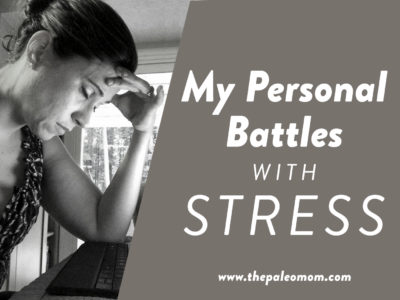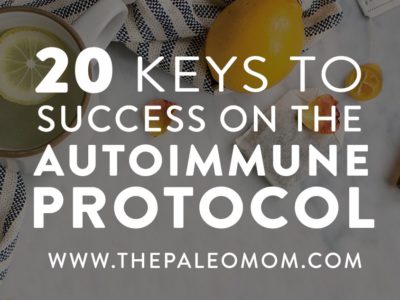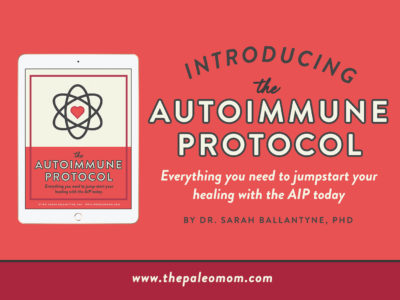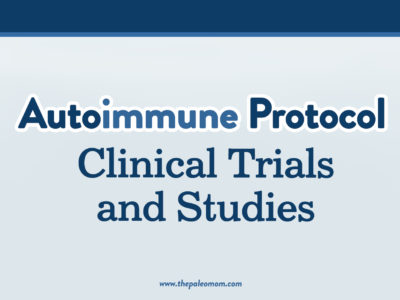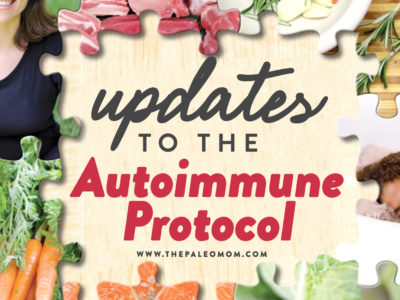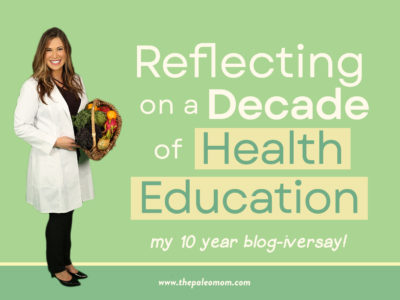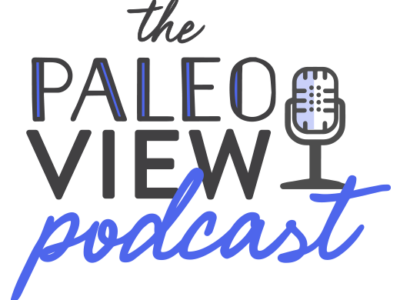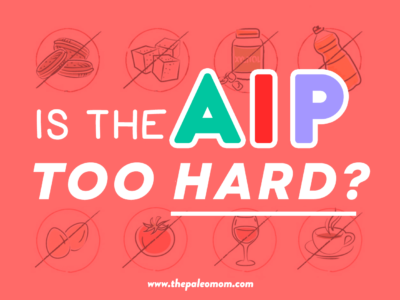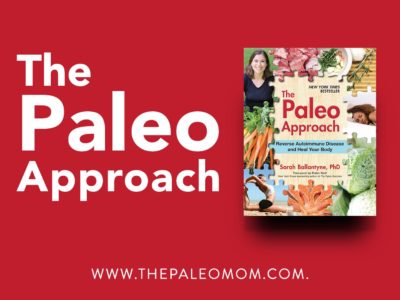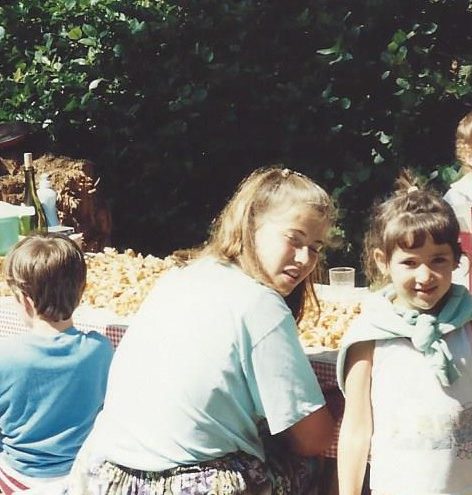 My autoimmune disease symptoms started with puberty—fatigue, chronic constipation, migraines, steady and unrelenting weight gain that didn’t scale with my high activity level or caloric intake, a litany of skin problems, dry and thinning hair, brittle and thin fingernails, chronic joint pain, mild depression and anxiety. Throughout my teens and twenties, I just seemed to rack up the diagnoses, mostly labels for my symptoms (like Irritable Bowel Syndrome and Gastroesophageal Reflux Disease to explain my gastrointestinal symptoms), but also new conditions related to inflammation that often seemed to come out of nowhere (like adult-onset asthma so severe that it presented similar to a pulmonary embolism, resulting in me being housebound for months while taking very high doses of prednisone). I didn’t seem capable of losing weight and keeping it off no matter what I tried—two decades on the diet yo-yo left me completely defeated, with binge-eating disorder, morbid obesity, metabolic syndrome, and a virtually non-existent sense of self-worth. By age 30, I had over a dozen diagnosed health conditions, including two out of the four autoimmune diseases I now know I have, and a medicine cabinet full of prescription and OTC drugs.
My autoimmune disease symptoms started with puberty—fatigue, chronic constipation, migraines, steady and unrelenting weight gain that didn’t scale with my high activity level or caloric intake, a litany of skin problems, dry and thinning hair, brittle and thin fingernails, chronic joint pain, mild depression and anxiety. Throughout my teens and twenties, I just seemed to rack up the diagnoses, mostly labels for my symptoms (like Irritable Bowel Syndrome and Gastroesophageal Reflux Disease to explain my gastrointestinal symptoms), but also new conditions related to inflammation that often seemed to come out of nowhere (like adult-onset asthma so severe that it presented similar to a pulmonary embolism, resulting in me being housebound for months while taking very high doses of prednisone). I didn’t seem capable of losing weight and keeping it off no matter what I tried—two decades on the diet yo-yo left me completely defeated, with binge-eating disorder, morbid obesity, metabolic syndrome, and a virtually non-existent sense of self-worth. By age 30, I had over a dozen diagnosed health conditions, including two out of the four autoimmune diseases I now know I have, and a medicine cabinet full of prescription and OTC drugs.
I often say that my main motivation for everything I do now is to help people find the answers they need without having to hit the health lows that I did before finding the Paleo diet and the Autoimmune Protocol. But, I do also want to recognize that, in many ways, growing up with autoimmune disease forged who I am. While my intelligence and talent are innate, I believe that my ambition and work ethic were borne out of striving for academic excellence while feeling exhausted and in pain almost all of the time (being too tired to get into teenage mischief helped too).
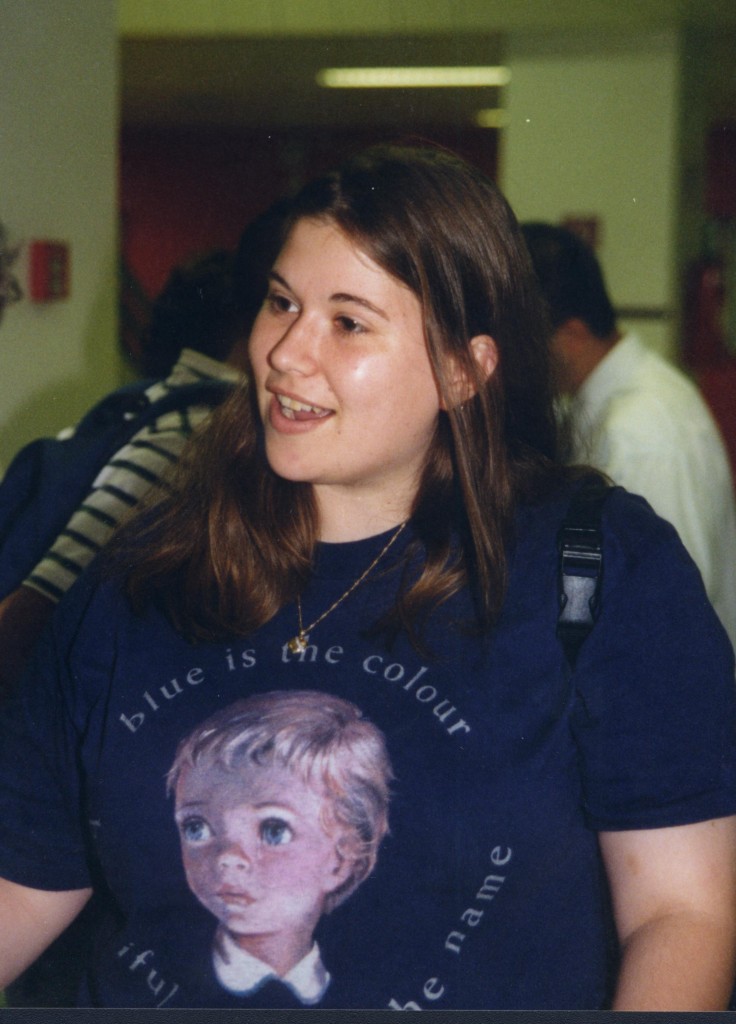 My stubbornness and resolve arose from being mercilessly bullied as “the fat kid” on the playground, too often facing misogyny as a woman seeking a high-profile career in male-dominated scientific fields, and the experience of rising up from the poverty of my childhood. My passion for helping others was ignited by decades of seeking help from medical professionals and being figuratively patted on the head and told that I was just a stressed student who needed Prozac and to count my calories and exercise. Without the qualities developed from those experiences, I wouldn’t be able to do what I’m doing now: leading a revolution in the alternative health community by educating autoimmune disease sufferers on the role that diet and lifestyle play in both their disease activity and in disease management.
My stubbornness and resolve arose from being mercilessly bullied as “the fat kid” on the playground, too often facing misogyny as a woman seeking a high-profile career in male-dominated scientific fields, and the experience of rising up from the poverty of my childhood. My passion for helping others was ignited by decades of seeking help from medical professionals and being figuratively patted on the head and told that I was just a stressed student who needed Prozac and to count my calories and exercise. Without the qualities developed from those experiences, I wouldn’t be able to do what I’m doing now: leading a revolution in the alternative health community by educating autoimmune disease sufferers on the role that diet and lifestyle play in both their disease activity and in disease management.
Nutrivore Weekly Serving Matrix
An easy-to-use and flexible weekly checklist
to help you maximize nutrient-density.
The Weekly Serving Matrix is very helpful! I’ve been eating along these lines but this really helps me know where to focus vs. which foods serve a more secondary role. It’s super helpful and has taken a lot of worry out of my meal planning. Thanks!
Jan
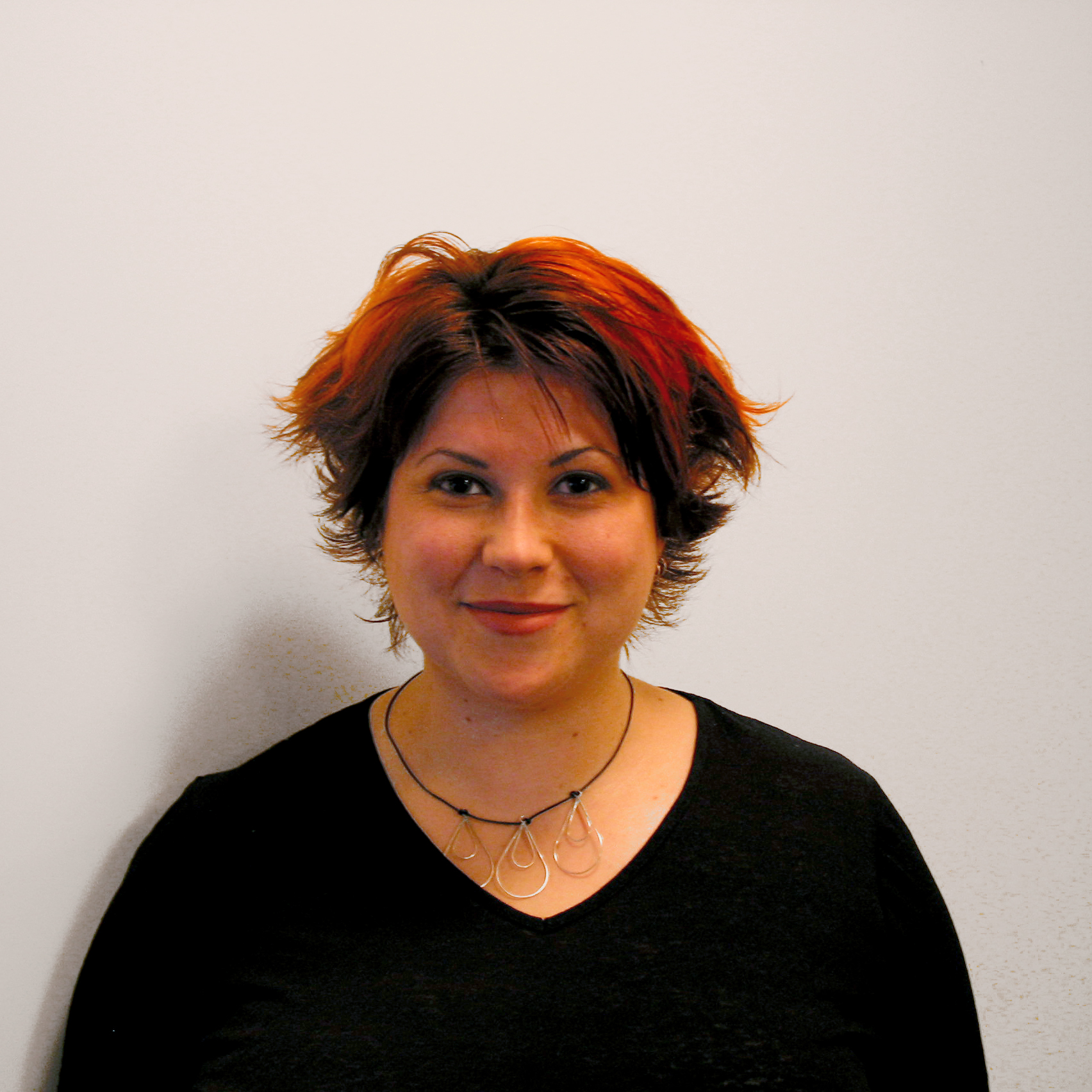 If you’d asked my in my teens or twenties, I would have told you that my health problem [problem, singular] was being overweight. Those dozen diagnosed chronic health conditions didn’t seem separate to me from being obese. And obesity, to me, felt like wearing a sign at all times that read “Look at me! I’m unhealthy! I’m a failure!”. Despite my academic achievements (including graduating with distinction with an Honors Bachelors of Science, earning my PhD in medical biophysics by the age of 26, numerous scholarships and awards for research excellence, securing post-doctoral research positions in some of the highest profile laboratories in the country, getting my own grant funding as a post-doctoral research fellow, and publishing highly-cited papers in top-tier journals), being morbidly obese was an undercurrent that eroded all sense of accomplishment that I should have felt. I made up for it by cursing regularly, dying my hair crazy bright colors (blue, purple, platinum, fire engine red…), wearing power suits, and generally putting on a show of assertiveness that I never really felt, covering up my impostor syndrome with a confident exterior. So, I naively thought that, if I could just lose the weight and solve that problem, everything in my life would fall into place.
If you’d asked my in my teens or twenties, I would have told you that my health problem [problem, singular] was being overweight. Those dozen diagnosed chronic health conditions didn’t seem separate to me from being obese. And obesity, to me, felt like wearing a sign at all times that read “Look at me! I’m unhealthy! I’m a failure!”. Despite my academic achievements (including graduating with distinction with an Honors Bachelors of Science, earning my PhD in medical biophysics by the age of 26, numerous scholarships and awards for research excellence, securing post-doctoral research positions in some of the highest profile laboratories in the country, getting my own grant funding as a post-doctoral research fellow, and publishing highly-cited papers in top-tier journals), being morbidly obese was an undercurrent that eroded all sense of accomplishment that I should have felt. I made up for it by cursing regularly, dying my hair crazy bright colors (blue, purple, platinum, fire engine red…), wearing power suits, and generally putting on a show of assertiveness that I never really felt, covering up my impostor syndrome with a confident exterior. So, I naively thought that, if I could just lose the weight and solve that problem, everything in my life would fall into place.
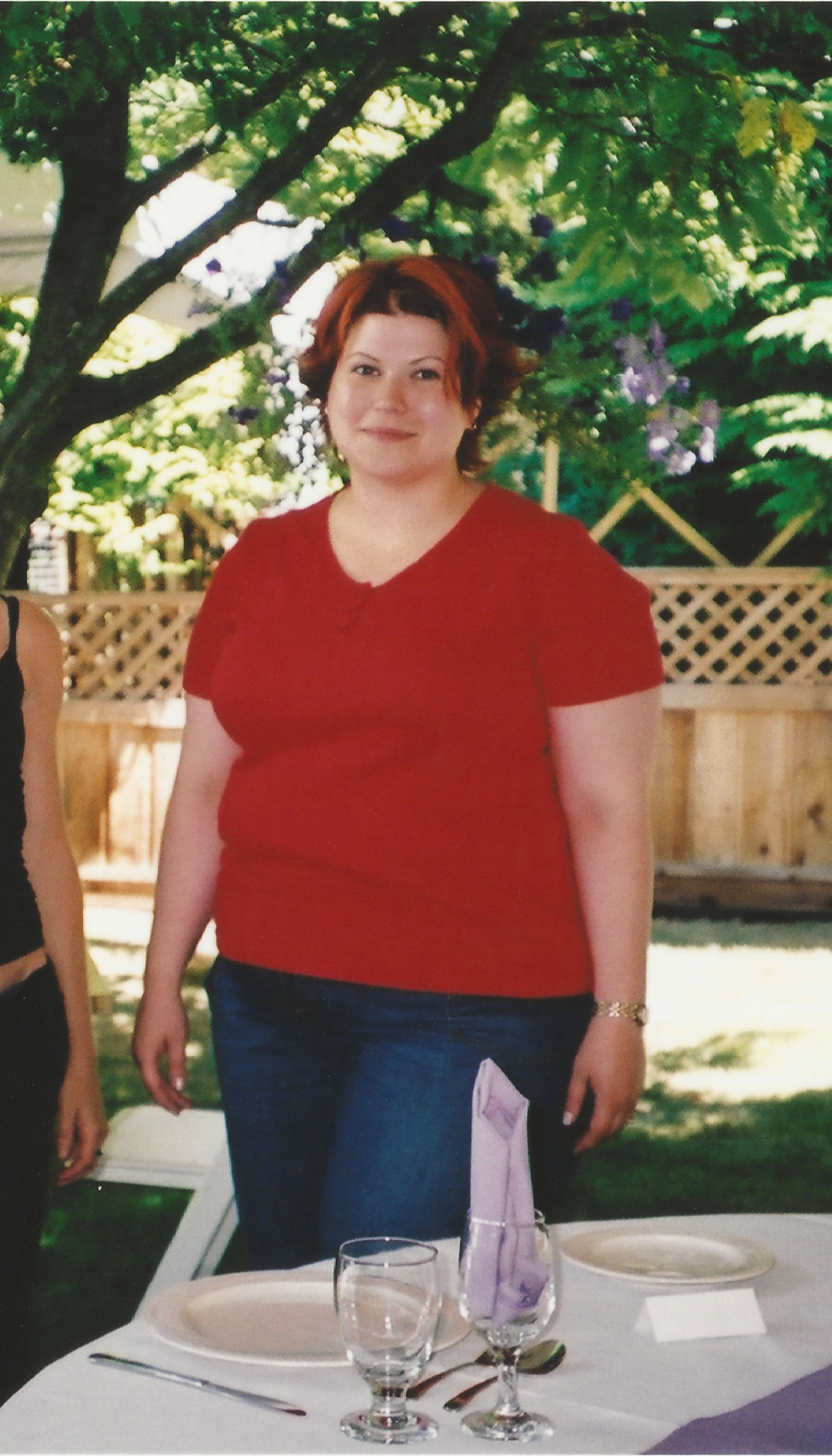 Then in 2007, I had my first daughter. Still obese when I conceived, my pregnancy was complicated by gestational diabetes and pre-eclampsia. My newborn had colic and rarely slept more than 45 minutes at a time. She wouldn’t latch onto a bottle, so I was up all night nursing her. And, I couldn’t do it. I was too sick to balance motherhood and applying to tenure-track faculty positions, the expectation being that I would continue to work 80-hour weeks until I had established my own research program and a perfect self-renewing cycle of grant funding, a process that typically takes years. I had wanted to be a medical researcher from the time I was 7-years old, and here I was, unable to take that final step. The autoimmune diseases that fueled my stubborn desire to succeed were now stopping me from achieving a two-decades-old life goal. And, yet denial is powerful force: I still blamed my weight; I said that I was inspired by my mom staying home when I was young; I credited a program by the National Institutes for Health (called reentry grants for women) for giving me the option to take a few years off; and I called it “a break”.
Then in 2007, I had my first daughter. Still obese when I conceived, my pregnancy was complicated by gestational diabetes and pre-eclampsia. My newborn had colic and rarely slept more than 45 minutes at a time. She wouldn’t latch onto a bottle, so I was up all night nursing her. And, I couldn’t do it. I was too sick to balance motherhood and applying to tenure-track faculty positions, the expectation being that I would continue to work 80-hour weeks until I had established my own research program and a perfect self-renewing cycle of grant funding, a process that typically takes years. I had wanted to be a medical researcher from the time I was 7-years old, and here I was, unable to take that final step. The autoimmune diseases that fueled my stubborn desire to succeed were now stopping me from achieving a two-decades-old life goal. And, yet denial is powerful force: I still blamed my weight; I said that I was inspired by my mom staying home when I was young; I credited a program by the National Institutes for Health (called reentry grants for women) for giving me the option to take a few years off; and I called it “a break”.
My Paleo First Steps
After losing 100 pounds on a low-carb diet (spurred by realizing that I had developed type 2 diabetes when my oldest daughter was one year old, and facilitated by the fact that I wasn’t working), I was frustrated to discover that my life wasn’t magical unicorns and rainbows. In fact, while losing weight reversed my metabolic syndrome and normalized by blood sugar levels, all of my other disease symptoms worsened—my migraines were more frequent, my joint pain was more unrelenting, my asthma and gastrointestinal symptoms required higher doses of medication to manage, my depression was bigger, my anxiety attacks were more frequent, and my skin was a mess! I had eczema, acne, and my two autoimmune skin conditions—lichen planus and psoriasis—were in full flare. I had lost most of the weight I needed to lose, but it still felt like I was wearing that failure sign plastered across my forehead.
In the summer of 2011, I was sitting in my second daughter’s bedroom watching her play (she was 1 1/2 years old at the time), wearing long sleeves and pants to hide my skin, the weather in the mid-90s (mid-30s Celsius), hot, miserable and in pain… when I had my epiphany.
The words thin and the words healthy don’t mean the same thing.
I was active, and only 30 pounds from my goal weight, but I wasn’t healthy. I was missing something.
That’s when I started to think about diet in terms other than what I needed to eat (or not eat) to lose weight. Gazing at my inflamed skin, I remembered a tidbit I had picked up somewhere about eczema being linked to egg allergy; and, I began to wonder if my collection of skin conditions were caused by the food I was eating. I turned to Dr. Google and found an article on the original version of thepaleodiet.com talking about lichen planus and the Paleo diet; Professor Cordain linked to a few scientific studies at the bottom of that article. I thought three things:
- “oh, this is that weirdo diet that Chad is doing” (my friend from undergrad who actually introduced me to my now husband);
- “there’s no [expletive] way I’m doing this [expletive] crazy diet and cutting out all those foods”; and,
- “ooh, scientific studies to read!”
The science was my hook. I took the next few months to read as much as I could about the Paleo diet. I read The Paleo Solution by Robb Wolf and The Paleo Answer by Loren Cordain. I dove into PubMed and read the studies that Professor Cordain cited. And, it all started to make sense. I started to understand lectins and antinutrients. Despite conducting medical research on the immune system and the gut barrier, all of my research background was either focused on basic science or drug development (as most medical research is). I needed to teach myself nutritional sciences. Fortunately, I had experience switching scientific fields, so teaching myself a new branch of science was something I had the skills to do. Eventually I had learned enough to realize that I had nothing to lose, but I would see Robb Wolf’s “try it for 30 days and see how you look, feel and perform” and raise him another 60 days. On August 31st, 2011, I dove head-first into Paleo, with an initial commitment of 3 months.
From Paleo to The Paleo Mom
After two weeks of a standard Paleo diet, I was able to discontinue all six prescription medications I was on at the time (medications for asthma, allergies, GERD and IBS). I haven’t had a migraine since (except for the few times I’ve accidentally consumed dairy). My IBS and GERD completely disappeared. My anxiety attacks stopped. My energy improved. My aches and pains diminished greatly. My asthma no longer required daily medications to control. My weird allergies (like breaking out into a rash every time I touched cardboard) went away. My eczema and acne cleared. I started losing weight again despite having been plateaued for months. And, I became a zealot. I was all in. Like, let’s start a blog as an outlet for my enthusiasm level dedicated to the Paleo cause.
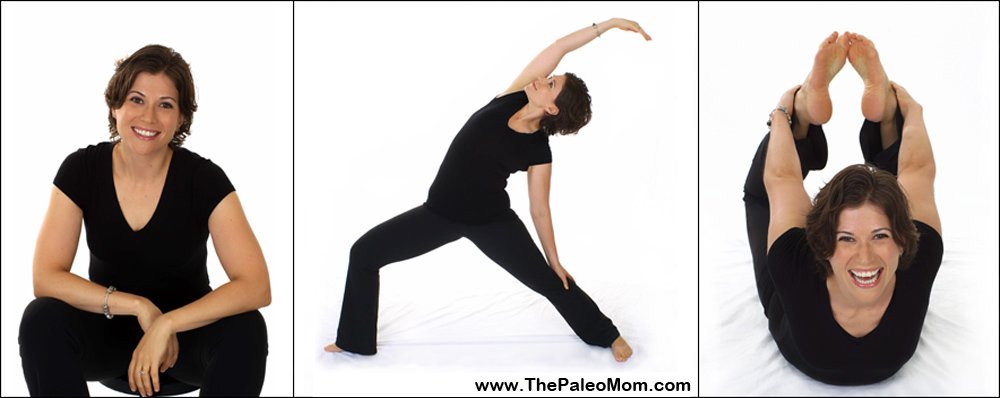
I never intended my website to become a career. As far as I was concerned, my plan was still to return to medical research once my youngest daughter was in school. I was simply nerding out over the science behind Paleo and enjoyed the exercise of writing about it in my own words—doing so provided me a link to the career I so deeply missed. I decided to transition my husband and kids to Paleo (read more about their stories in About Dr. Sarah’s Family) and I enjoyed sharing that experience with the anonymous internet. I was having fun experimenting in the kitchen and was proud to share my creations. ThePaleoMom.com was a great hobby. And then, it took off. People love the way I explain complex scientific concepts. They love my recipes. My story resonates. My audience grew, rapidly and completely organically. And, ten short months after I wrote my first blog post, I was offered book deals from two different publishers a week and a half apart from one another.
My AIP First Steps
As magical as those first few months of Paleo were, it wasn’t enough to actually fix everything. I still had lichen planus lesions and scalp psoriasis. I was convinced of the role of diet in my health, but I needed to dig deeper. That’s when I discovered that lichen planus and psoriasis are autoimmune diseases. Autoimmune. That word. Where had I seen it before? Ah yes, page 201 of The Paleo Solution, a three-quarter-page inset titled “Autoimmune Caveat”. Robb recommended additionally eliminating eggs, nuts, seeds, tomatoes, potatoes, eggplants and peppers for a month or two for anyone with autoimmune or inflammatory issues (in addition to grains, legumes, dairy and manufactured foods—a typical definition of the Paleo diet in those days was a list of foods to avoid). In Chapter 9 of The Paleo Answer, Professor Cordain recommends that autoimmune disease sufferers additionally eliminate nightshades, alcohol, NSAIDS, oral contraceptives, and antacids (again in addition to strict avoidance of grains, pseudograins, legumes, and dairy—no 80/20 rule for us autoimmune folks). I found two websites at the time that combined these two overlapping-but-not-identical lists of foods and that dubbed them “The Autoimmune Protocol”. I decided I needed to try it, so as a New Year’s resolution for 2012, I eliminated all of the above.
 The scientific explanations for these additional eliminations weren’t robust enough to satisfy me (I continue to this day to dislike the typical diet book formula, where the assumption is that the reader doesn’t care about science so all of the scientific evidence is glossed over, oversimplified, and reduced to ridiculous analogies), so I dove into the scientific literature on immune function and the intersection with prolamins, agglutinins, phytates, glycoalkaloids and lysozyme. Dr. Terry Wahls’ TedxIowaCity talk had just gone viral and I was learning about the roles of vitamins, minerals, amino acids, fatty acids, phytonutrients, and fiber. I was sold on nutrient density, so I worked on upping my vegetable intake and eating organ meat. My oldest daughter started sleeping through the night for the first time (at 5 years old!) after we eliminated gluten from her diet, and how much better I felt got me interested in the role of sleep in immune function. That got me interested in other lifestyle factors. All of the immunology that I had learned in grad school suddenly became very relevant. And, already, my website was transitioning from a mommy blog to the comprehensive health education site that it is today.
The scientific explanations for these additional eliminations weren’t robust enough to satisfy me (I continue to this day to dislike the typical diet book formula, where the assumption is that the reader doesn’t care about science so all of the scientific evidence is glossed over, oversimplified, and reduced to ridiculous analogies), so I dove into the scientific literature on immune function and the intersection with prolamins, agglutinins, phytates, glycoalkaloids and lysozyme. Dr. Terry Wahls’ TedxIowaCity talk had just gone viral and I was learning about the roles of vitamins, minerals, amino acids, fatty acids, phytonutrients, and fiber. I was sold on nutrient density, so I worked on upping my vegetable intake and eating organ meat. My oldest daughter started sleeping through the night for the first time (at 5 years old!) after we eliminated gluten from her diet, and how much better I felt got me interested in the role of sleep in immune function. That got me interested in other lifestyle factors. All of the immunology that I had learned in grad school suddenly became very relevant. And, already, my website was transitioning from a mommy blog to the comprehensive health education site that it is today.
I felt like I was figuring out what the Autoimmune Protocol even was while I figured out how to implement it—not because there was a need for additional communication (although there was), but because the protocol itself was so rudimentary at the time that it was hard to even apply the term protocol. I researched all of the details, expanding the protocol and writing about each facet as I learned, adding the pillars of nutrient-density, sleep, stress management and activity, and making calls on those gray-area foods for which there was no guidance, solidifying the eliminations. I was integrating my other knowledge into the protocol, changing its focus from the negative what to avoid, to the positive what to eat, emphasizing lifestyle in addition to diet. I was developing recipes, trying to figure out how to eat AIP on a tight budget, and trying to understand what was specific to my body versus generally applicable and supported by scientific consensus. I bonded with a small group of other bloggers who were also implementing the AIP for their own health reasons, and who were following along with my research and also refining and writing as they went, and helping to spread the word to their own audiences (Mickey Trescott and Angie Alt of Autoimmune Wellness, Eileen Laird of Phoenix Helix, Christina Feindel of A Clean Plate, and Whitney of Nutrisclerosis). We were the small seed of what is now a vibrant AIP community, and we supported each other in both our health and professional journeys.
Popularizing the AIP
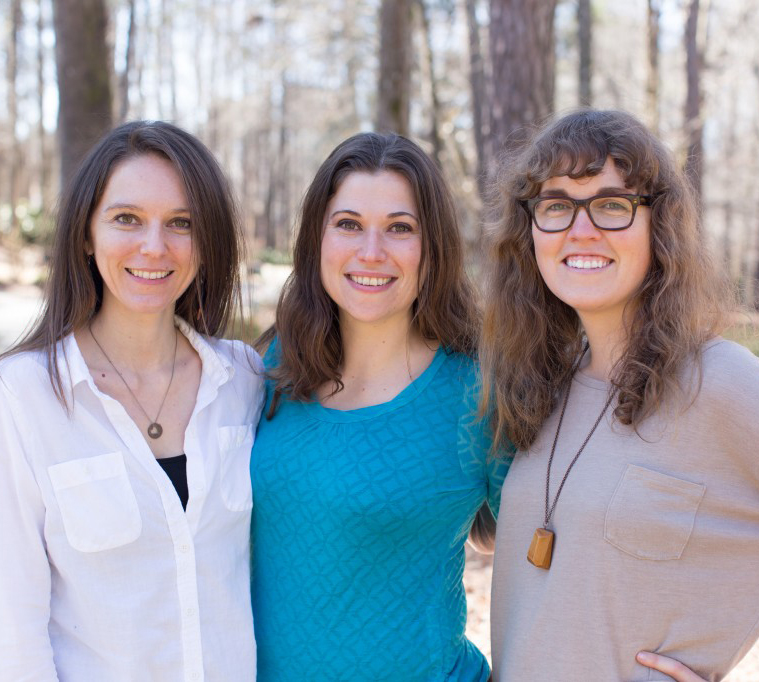 While technically the Autoimmune Protocol predated by entry into the Paleo and AIP communities, I recognize that it would not be what it is today without my research and my writing. Truly, I was just trying to figure out the missing pieces of my own health, but I intuitively understood that I’m not alone in this struggle, nor am I the only supernerd hungry for the scientific evidence in the world. As I researched the reasons for each AIP elimination, I started being able to rank their importance, and make judgment calls on the many foods and ingredients for which no prior determination had been made. And I started to understand the nutritional requirements of the immune system, I integrated a nutrient-density focus to the AIP. As I took a more holistic approach for my own health, I started to write about how lifestyle factors impact immune function. I didn’t realize at the time that my research was transforming the Autoimmune Protocol from an obscure fad based on a basic list of eliminations to a valid and comprehensive dietary strategy to support people with autoimmune disease. I didn’t realize that my core belief in the importance of representing scientific evidence in an unbiased and nuanced way brought scientific validity to the AIP. And I certainly didn’t realize that, while I was counting down the days until my youngest started kindergarten so I could return to the research lab, that I was actually creating a new career for myself, something much more important.
While technically the Autoimmune Protocol predated by entry into the Paleo and AIP communities, I recognize that it would not be what it is today without my research and my writing. Truly, I was just trying to figure out the missing pieces of my own health, but I intuitively understood that I’m not alone in this struggle, nor am I the only supernerd hungry for the scientific evidence in the world. As I researched the reasons for each AIP elimination, I started being able to rank their importance, and make judgment calls on the many foods and ingredients for which no prior determination had been made. And I started to understand the nutritional requirements of the immune system, I integrated a nutrient-density focus to the AIP. As I took a more holistic approach for my own health, I started to write about how lifestyle factors impact immune function. I didn’t realize at the time that my research was transforming the Autoimmune Protocol from an obscure fad based on a basic list of eliminations to a valid and comprehensive dietary strategy to support people with autoimmune disease. I didn’t realize that my core belief in the importance of representing scientific evidence in an unbiased and nuanced way brought scientific validity to the AIP. And I certainly didn’t realize that, while I was counting down the days until my youngest started kindergarten so I could return to the research lab, that I was actually creating a new career for myself, something much more important.
 When deciding between my book deal offers, I was choosing between writing a Paleo desserts cookbook (one specific book deal offer) or a book of my choosing (the other offer). It was actually a really easy decision! The world needed a book about the Autoimmune Protocol. And, I had the glorious opportunity to write a book the way I wanted to, not shying away from science, but instead leaning into it. I didn’t need to gloss over scientific evidence, nor to condescend to banal analogies to belabor my points; but instead, I could take the time to explain detailed scientific concepts in a way that was approachable and accessible to a general audience. I could respect my audience, break free of the diet book mold, and create something unique both in format, and I hoped, in usefulness!
When deciding between my book deal offers, I was choosing between writing a Paleo desserts cookbook (one specific book deal offer) or a book of my choosing (the other offer). It was actually a really easy decision! The world needed a book about the Autoimmune Protocol. And, I had the glorious opportunity to write a book the way I wanted to, not shying away from science, but instead leaning into it. I didn’t need to gloss over scientific evidence, nor to condescend to banal analogies to belabor my points; but instead, I could take the time to explain detailed scientific concepts in a way that was approachable and accessible to a general audience. I could respect my audience, break free of the diet book mold, and create something unique both in format, and I hoped, in usefulness!
It took about 14 months from signing the contract to The Paleo Approach making it onto book shelves. Originally, The Paleo Approach and The Paleo Approach Cookbook were going to be one book, but my publisher realized when I turned in the first part, that my original plan was too ambitious and the book needed to be divided into two. Because I worked on both in tandem, they were both published in 2014. It was such an amazing learning experience to write a book, and I loved it (why I continue to write books!), like working on a review article (or seven) but dropping all the pretentious scientific jargon. I had not only found something that I was uniquely qualified and skilled at, but I also found something fulfilling beyond what I had ever experienced working at the lab bench.
 Thanks to referencing over 1200 scientific articles and to my writing style, The Paleo Approach became the definitive guidebook on the Autoimmune Protocol — creating the comprehensive protocol that exists today. I subsequently wrote two AIP cookbooks, The Paleo Approach Cookbook and The Healing Kitchen (the latter a collaboration with Alaena Haber of GrazeandEnthused.com); collaborated with Mickey Trescott and Angie Alt of AutoimmuneWelness.com to create the AIP Certified Coach practitioner training program; and created the AIP Lecture Series for autoimmune disease sufferers and their caregivers. My other interests led me to write Paleo Principles (now the definitive Paleo guidebook), The Gut Health Guidebook and The Gut Health Cookbook, and found Nutrivore.com, which will be launching soon.
Thanks to referencing over 1200 scientific articles and to my writing style, The Paleo Approach became the definitive guidebook on the Autoimmune Protocol — creating the comprehensive protocol that exists today. I subsequently wrote two AIP cookbooks, The Paleo Approach Cookbook and The Healing Kitchen (the latter a collaboration with Alaena Haber of GrazeandEnthused.com); collaborated with Mickey Trescott and Angie Alt of AutoimmuneWelness.com to create the AIP Certified Coach practitioner training program; and created the AIP Lecture Series for autoimmune disease sufferers and their caregivers. My other interests led me to write Paleo Principles (now the definitive Paleo guidebook), The Gut Health Guidebook and The Gut Health Cookbook, and found Nutrivore.com, which will be launching soon.
But it took me years to release an e-book guide on the Autoimmune Protocol, something that, looking back, seems like it should have been an obvious resource for me to have created from the very beginning. The reason for the delay is wrapped up in my reluctance to take ownership of the AIP (holdovers of having worn that failure sign for so long), and, because my career as an author and health educator is an accidental one, my lack of understanding, until recently, that the most robust online educational medium that I can use to communicate with people is all of them, everywhere, all at once.
Taking Ownership of the AIP
 This is the hardest part of my AIP journey for me to write about, and something that I’ve never discussed publicly before. I was reluctant to be viewed as an, or even the, AIP leader and creator. I acknowledge that the AIP would not be what it is today without my extensive work, the overly simplistic origins would likely have fizzled into obscurity. I took something that existed only in a very rudimentary form, and through my research and writing, I expanded it, refined it, fine-tuned it, gave it scientific credibility, and popularized it. But at the same time, like a master baker creating a gorgeous wedding cake using a collection of ingredients that likely came from different sources, I had a starting place, inspiration and mentors, colleagues and likeminded individuals, all in addition to my research skills and my own passion—my own ingredients to use to create something beautiful. And, just like that master baker needs a community to elevate them, so too did I have that community, an amazing group of AIP bloggers to amplify my work so that it could take on a life of its own. This is why I resonate with the term creator, rather than founder or inventor or originator or architect or engineer or developer, because it can encompass both my invaluable work to make the AIP what it is today but also acknowledges the contributions of so many others…. like the master baker could not create her masterpiece without the chocolatier or the florist or the farmer.
This is the hardest part of my AIP journey for me to write about, and something that I’ve never discussed publicly before. I was reluctant to be viewed as an, or even the, AIP leader and creator. I acknowledge that the AIP would not be what it is today without my extensive work, the overly simplistic origins would likely have fizzled into obscurity. I took something that existed only in a very rudimentary form, and through my research and writing, I expanded it, refined it, fine-tuned it, gave it scientific credibility, and popularized it. But at the same time, like a master baker creating a gorgeous wedding cake using a collection of ingredients that likely came from different sources, I had a starting place, inspiration and mentors, colleagues and likeminded individuals, all in addition to my research skills and my own passion—my own ingredients to use to create something beautiful. And, just like that master baker needs a community to elevate them, so too did I have that community, an amazing group of AIP bloggers to amplify my work so that it could take on a life of its own. This is why I resonate with the term creator, rather than founder or inventor or originator or architect or engineer or developer, because it can encompass both my invaluable work to make the AIP what it is today but also acknowledges the contributions of so many others…. like the master baker could not create her masterpiece without the chocolatier or the florist or the farmer.
Now, the majority of people find the AIP through my work, and the now vibrant community of AIP bloggers who all rallied behind The Paleo Approach as their singular definitive AIP guide. With the success of The Paleo Approach (it’s a New York Times bestseller), I became the deciding voice on whether or not some ingredient would be considered part of the Autoimmune Protocol or not. I actually always enjoyed this responsibility — for me, it just means spending a few hours searching around PubMed for compelling reasons to include or exclude the food in question based on its impact (or lack thereof) on the immune system, hormones, the gut barrier or the gut microbiome. That’s fun for me. Many AIP bloggers then took it upon themselves to police the AIP, calling out any recipe or packaged food labeled as such that included verboten ingredients, to protect everyone following the AIP from erroneous information and potentially problematic foods, maintaining the clarity and integrity of my AIP messaging. And, this wonderful group of AIP bloggers enhanced the AIP community with their recipes, tips, strategies, and personal stories.
Also, I’m a scientist. And as such, I believe that knowledge belongs to everyone. The Autoimmune Protocol is based on scientific knowledge, something everyone should have access to. It felt conceited and power-hungry to view the AIP as my singular responsibility, as my possession. I’m also terrible at self-promotion, perhaps driven by some lingering impostor syndrome (I can’t express how challenging it is to write about myself and my vulnerabilities like this!). I’m much more in my element when I’m reading scientific papers, writing or teaching. It’s taken years for my perspective to shift, and not to one where I feel like the AIP belongs to me, but rather I feel like, as the person who created what it is today and best understands all of the science that goes into it, I am best equipped to protect the Autoimmune Protocol. Not ownership per se, but stewardship. That doesn’t mean keeping the AIP static. In fact, I strongly believe the AIP needs to adapt and update as new scientific studies that inform various aspects of the AIP are performed and as we start so see the results of AIP clinical trials (see Updates to the Autoimmune Protocol). But, I want to protect the AIP from commercialization, pyramid schemes of supplements that somehow mean you don’t need to do the hard work, from bastardization, unjustified modification to the point where the therapeutic potential is lost, and from dilution, where the central message behind the AIP is drowned out by a cacophony of unfocused, useless recommendations.
I am indebted to the Autoimmune Protocol for my current good health, for the influence I’ve been able to have on the medical community and the alternative health community, and for my ability to truly make a different in people’s lives. And, the best way for me to return the favor is to work to maintain the integrity of the AIP, to keep it freely available, to support the AIP’s current transition into the mainstream, and to embrace my role as the world’s leading expert and authority on the Autoimmune Protocol. It’s not a position I sought, but it’s one I feel obligated and honored to have.
Part of my transition to feeling comfort in my role as the AIP creator and steward was recognizing the need to enhance my ability to communicate with the hundreds of thousands of people using the Autoimmune Protocol to mitigate their diseases. That was the major driver behind creating The Autoimmune Protocol e-book. In one digital resource, I was able to update the Autoimmune Protocol, provide a quick-start for anyone new to the protocol, help everyone well into their AIP journeys hone in on the most important facets of the protocol to get the most out of it, and develop a method to communicate directly with you regarding all things AIP.
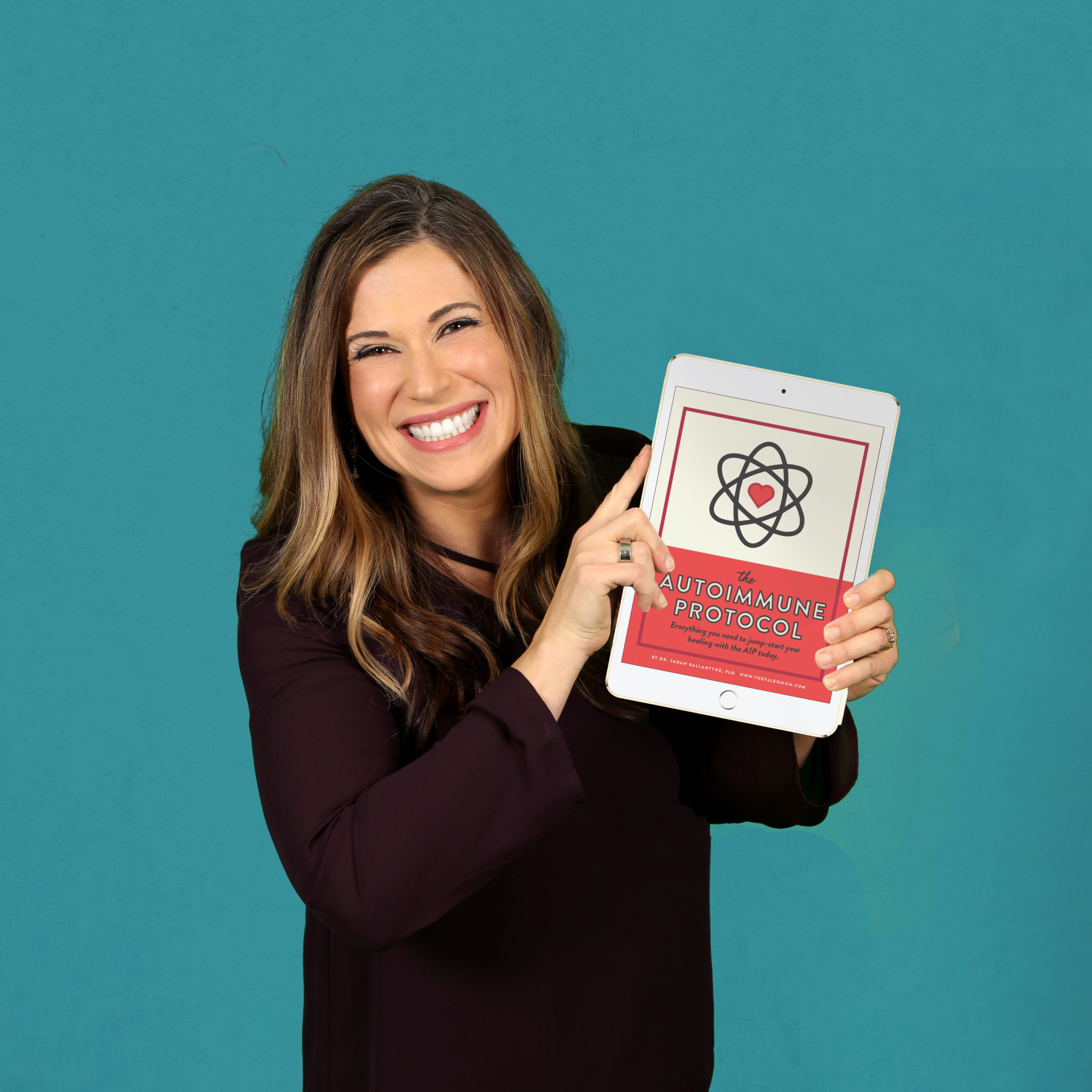 In a normal world, I would have written The Autoimmune Protocol e-book long before ever getting a book deal. The e-book would have gone through iterations, and when I did finally write an in-print book, it would have been based on a refined version of my e-book. Because my audience grew so quickly out of the gate, I ended up writing The Paleo Approach first. And then, I was scared that if I released an e-book on the Autoimmune Protocol, that it would cannibalize sales of The Paleo Approach, a terrifying prospect given that I have long relied on book sales to support my website and team. That’s why it took me 5 years to put together The Autoimmune Protocol e-book. I think I needed the experience of creating the AIP Certified Coach practitioner training program and teaching The AIP Lecture Series to realize that my resources layer on top of each other, that each of these ways of learning about the Autoimmune Protocol support each other. The best way that I can increase recognition of the Autoimmune Protocol, to perform my stewardship duties, is to provide as vast a collection of AIP resources, all at different levels of detail, as possible. And on the bright side, The Autoimmune Protocol e-book is a really darned awesome resource, far better than I could have created five years ago!
In a normal world, I would have written The Autoimmune Protocol e-book long before ever getting a book deal. The e-book would have gone through iterations, and when I did finally write an in-print book, it would have been based on a refined version of my e-book. Because my audience grew so quickly out of the gate, I ended up writing The Paleo Approach first. And then, I was scared that if I released an e-book on the Autoimmune Protocol, that it would cannibalize sales of The Paleo Approach, a terrifying prospect given that I have long relied on book sales to support my website and team. That’s why it took me 5 years to put together The Autoimmune Protocol e-book. I think I needed the experience of creating the AIP Certified Coach practitioner training program and teaching The AIP Lecture Series to realize that my resources layer on top of each other, that each of these ways of learning about the Autoimmune Protocol support each other. The best way that I can increase recognition of the Autoimmune Protocol, to perform my stewardship duties, is to provide as vast a collection of AIP resources, all at different levels of detail, as possible. And on the bright side, The Autoimmune Protocol e-book is a really darned awesome resource, far better than I could have created five years ago!
The Common Themes of My Journey
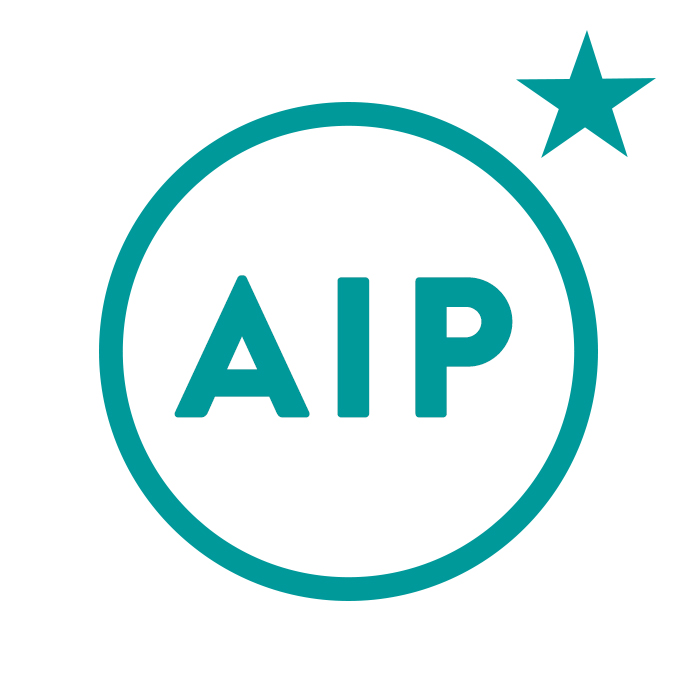 Let’s face the bitter truth: my experiences of facing prejudice and bullying, of not being taken seriously by my doctors, of struggling with symptoms for decades before I knew the name of my autoimmune diseases, of being so defeated by my symptoms that I believed I deserved how I felt. . . those experiences aren’t unique to me. Variations of those experiences are the common theme of life with autoimmune disease. And it just shouldn’t be that way! But what’s also amazing is that my experience of feeling so inspired and indebted to the AIP that I committed my life to educating others about it isn’t unique either! There are so many talented AIP bloggers out there creating AIP resources, recipes, cookbooks, all to help drive this movement forward. And, each one of them has an inspirational story of healing. Here are just some of my favorite stories from AIP bloggers:
Let’s face the bitter truth: my experiences of facing prejudice and bullying, of not being taken seriously by my doctors, of struggling with symptoms for decades before I knew the name of my autoimmune diseases, of being so defeated by my symptoms that I believed I deserved how I felt. . . those experiences aren’t unique to me. Variations of those experiences are the common theme of life with autoimmune disease. And it just shouldn’t be that way! But what’s also amazing is that my experience of feeling so inspired and indebted to the AIP that I committed my life to educating others about it isn’t unique either! There are so many talented AIP bloggers out there creating AIP resources, recipes, cookbooks, all to help drive this movement forward. And, each one of them has an inspirational story of healing. Here are just some of my favorite stories from AIP bloggers:
I hope that my story and those of the above AIP bloggers inspire you to learn more about the Autoimmune Protocol, dive deeper, and take your next step on your path to health. So, if you want to learn more about the AIP or share resources with a friend or family member, here’s my suggested order to go through my resources:
- Read my summary webpage on the Autoimmune Protocol here. (There’s lots of links to specific articles too.)
- Get my free AIP Quick-Start Guide here.
- Grab a copy of The Autoimmune Protocol e-book (it’s only $20 and your purchase helps support this website).
- Read The Paleo Approach. (You can also cook out of The Paleo Approach Cookbook and The Healing Kitchen.)
- Sign up for the next session of The AIP Lecture Series.
- If you’re a healthcare professional or wellness provider, check out the AIP Certified Coach practitioner training program.
And please note that any purchase from ThePaleoMom.com helps to support me, my team (without whom I couldn’t do even a fraction of what I do), and the costs of operating this site. Thank you!

Get the Definitive AIP Resource
The Paleo Approach is the New York Times bestselling epic guidebook that explains all of the detailed WHYs behind every facet of the Paleo Autoimmune Protocol.
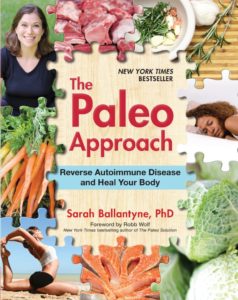
You may enjoy these related posts:
My Personal Journey as a Blogger
My 8 year blogiversary was last week, eight (!) whole years since that fateful …
My Personal Battles with Stress
This has been a hard post to write. It has always been important to me to be …
20 Keys to Success on the Autoimmune Protocol
My good friends Mickey and Angie at autoimmune-Paleo.com have created what they …
Announcing The Autoimmune Protocol E-book!
Da-da da da da daaaaah! I’m so excited to finally be able to launch the e-book …
Autoimmune Protocol Clinical Trials and Studies
The Autoimmune Protocol, or AIP, is a science-based diet and lifestyle …
How The AIP Lecture Series Strengthened My Resolve and My Marriage – Guest Post by Shanna Nemrow
I am so deeply grateful to Shanna for first sharing her story with me, and …
Updates to the Autoimmune Protocol
My definitive guidebook on the Autoimmune Protocol, called The Paleo Approach: …
Reflecting on a Decade of Health Education
When I started ThePaleoMom.com on November 4, 2011, it was a culmination of …
TPV Podcast, Episode 40: Practical Autoimmune Protocol
In this episode, Stacy and Sarah invite Mickey Trescott of Autoimmune Paleo, …
Is the Autoimmune Protocol Too Hard?
There is one pervasive myth about the Autoimmune Protocol: It’s too hard. When …
Announcing My Book: The Paleo Approach–Reverse Autoimmune Disease and Heal Your Body
This project evolved considerably as I delved into it. To see the amazing …
Important Updates to The Autoimmune Protocol
I have been diligently working over the last few days to completely update The …

